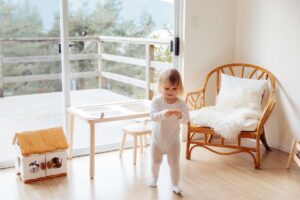Using designer furniture to decorate your home or office space is a great idea. Unfortunately, like every other furniture, they are not immune to the effects of aging and everyday use. Luckily, with proper care and maintenance, you can keep your designer furniture looking like new for years. If you want it to last, there are a few things you need to do differently from your usual housekeeping routine. In this post, we have put together some great tips on how to maintain your designer furniture and without wasting any more time, let’s dive into it.
DON’T BE CHEAP
As with anything you spend a lot of money on, taking good care of your designer furniture is essential in protecting its value over time. High-end furniture requires high-end care. If you’re used to furniture that lasts a decade or so, paying extra attention to your new designer furniture is vital.
USE THE RIGHT KIND OF CLEANING SOLUTION
Most of us don’t think about cleaning our furniture; we just dust around it and clean up any surface dirt. But when you keep your furniture in immaculate condition, you’re able to enjoy it for longer periods of time without having to replace it – or spend a lot on repairs. When searching for a cleaning solution, avoid products that have soap, baking soda or other harsh chemicals. Instead, search for cleaners that are environmentally friendly and use ingredients like citrus and tea tree oil. Of course, check with your furniture store if you aren’t sure what cleaner they recommend.
DON’T USE DETERGENTS
Unless your furniture is covered in food, cat hair, or smelly gym clothes, don’t use detergents. They’ll leave behind a residue that will make your next spill stick like glue. And if you do need to clean your furniture with a soap-based product, always try it out on an inconspicuous area first to ensure that it won’t leave any unwanted streaks or marks behind. If your furniture is made of solid wood, chances are a slightly damp cloth and some elbow grease will be all you ever need to keep it looking its best. Make sure you keep up with regularly scheduled dusting and vacuuming too; even carpeted floors collect dirt over time, which shows up more easily than you might think. Carpets can often double as furniture padding, so it’s doubly important not to neglect them.
KEEP THEM AWAY FROM SUNLIGHT
You can’t see it, but UV rays from sunlight can damage any type of furniture. Try to place your furniture away from windows and doors, especially during hot summer months or if you have a larger piece of furniture (like a dining table) that you don’t use all year round. You should also consider storing your furniture in closed storage when not in use. Don’t leave a treasured piece of contemporary furniture out in direct sunlight for prolonged periods of time. This is especially important if you live in hot and humid areas with a lot of sun. Sunlight can fade fabrics and leathers faster than it does your skin, so be careful where you put your favourite pieces. It’s okay to expose smaller pieces like end tables and lamps out on display—just be careful with how much exposure they get.
REGULAR CLEANING AND MAINTENANCE
Contrary to popular belief, rust-proofing doesn’t prevent all furniture from rusting. It merely prevents surface rust on new products. If you want your designer furniture looking new for as long as possible, take care of it with regular cleaning and maintenance. Be sure not to leave any damp or wet items on your furniture and don’t forget that rainy days can lead to damage if you don’t properly protect your furniture against water damage. Finally, if you decide it’s time for a change, we can help! We at D’Touch Living Concept have many designer furniture and contemporary interior options that will keep your living space looking fresh. And remember: there are no rules when it comes to home décor; mix things up whenever you feel like it.
DON’T FORGET ABOUT MOVING PARTS
Keeping your furniture clean is important, but don’t forget about moving parts. Bolts can wear out over time, so lube them up periodically; if your drawers or doors are especially hard to open and close, consider using a bit of WD-40. Seating areas should be vacuumed with a soft brush attachment at least once per week, and cushions that can be removed from fabric covers should be spot cleaned on a regular basis. If you live in an apartment complex, remember that some landlords may require you to use specific cleaning products for fear of damaging their property; check with yours before proceeding.
Additionally, take care when moving any piece of furniture: Moving large pieces such as bookshelves shouldn’t present too much trouble, but any sofa or loveseat without wheels should be lifted onto its side before being moved—never ever try to move it by pushing it across its seat cushion. When it comes to maintaining fine furnishings without causing damage, more movement means more risk.
USE SOFT COTTON CLEANING CLOTHS
Dust attracts dust, so make sure you clean regularly with soft cotton cloths. Never use anything abrasive, like paper towels or sponges—these could damage surfaces and leave marks that are harder to remove than those left by dust. Modern furniture is designed to be durable; you should only need a soft damp cloth for regular cleaning. Don’t overdo it: If your living room furniture is your one splurge item, don’t feel pressured into covering it in plastic for protection 24/7. Leather can dry out when kept constantly covered and upholstery could collect moisture underneath its coating—neither of which will do anything good for its quality or appearance in future years.
TREAT SPILLS IMMEDIATELY!
Most stain removal experts recommend that you treat spills as soon as possible—ideally within 24 hours. The longer a stain sits, and is exposed to air, sunlight, or moisture, the harder it is to remove. For example, you may be able to get wine out of your carpet in time for your guests not to notice. But if someone spilled something more viscous—like olive oil—and left it for several days? You may have a different problem on your hands.
CONCLUSION
Formulas for designer furniture cleaning solutions vary, but many store-bought products are safe enough that you can use them at home. Look for a product that is non-toxic and protects wood finishes (such as varnish, stain or paint) while also removing dirt and dust. Specially formulated furniture cleaners tend to be less caustic than those used on floors and countertops. For example, boric acid can be used safely on wood surfaces; make sure it’s formulated for furniture though! If you have doubts about whether a cleaner is safe for your piece of designer furniture (or isn’t sure if it’s necessary), consult with a professional restorer.








